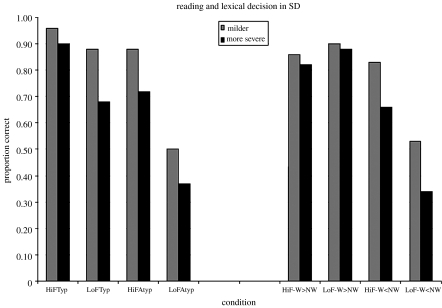Figure 1.
Results demonstrating how SD patients' success in two verbal tasks, one productive and one receptive, varies as a function of word frequency, stimulus typicality and patient severity. For both tasks, severity refers to the fact that the 14 patients have been divided into two equal subgroups on the basis of scores on a word+picture comprehension test. For the task of reading aloud (on the left), all stimuli were words, and the condition labels refer to a combination of the words’ frequency (HiF, high frequency; LoF, low frequency) and their spelling–sound typicality (Typ means that the word's pronunciation is typical for its spelling and Atyp that the pronunciation is atypical for or unpredictable from the word's spelling). For the task of lexical decision (on the right), each trial consisted of a word+non-word pair. HiF and LoF in the condition labels refer to the frequency of the real word. The remaining part of each label refers to the relative orthographic typicality of the word/non-word pairs in that condition: W>NW means that the word had more typical orthographic structure than the non-word, W<NW means the reverse.

